“In the past Saint Joseph was labelled as a ‘mediocre’ appellation, most likely because of its size and perceived variability. Yet today it is extremely hard to go wrong when selecting a good wine from this region,” writes Garnett.
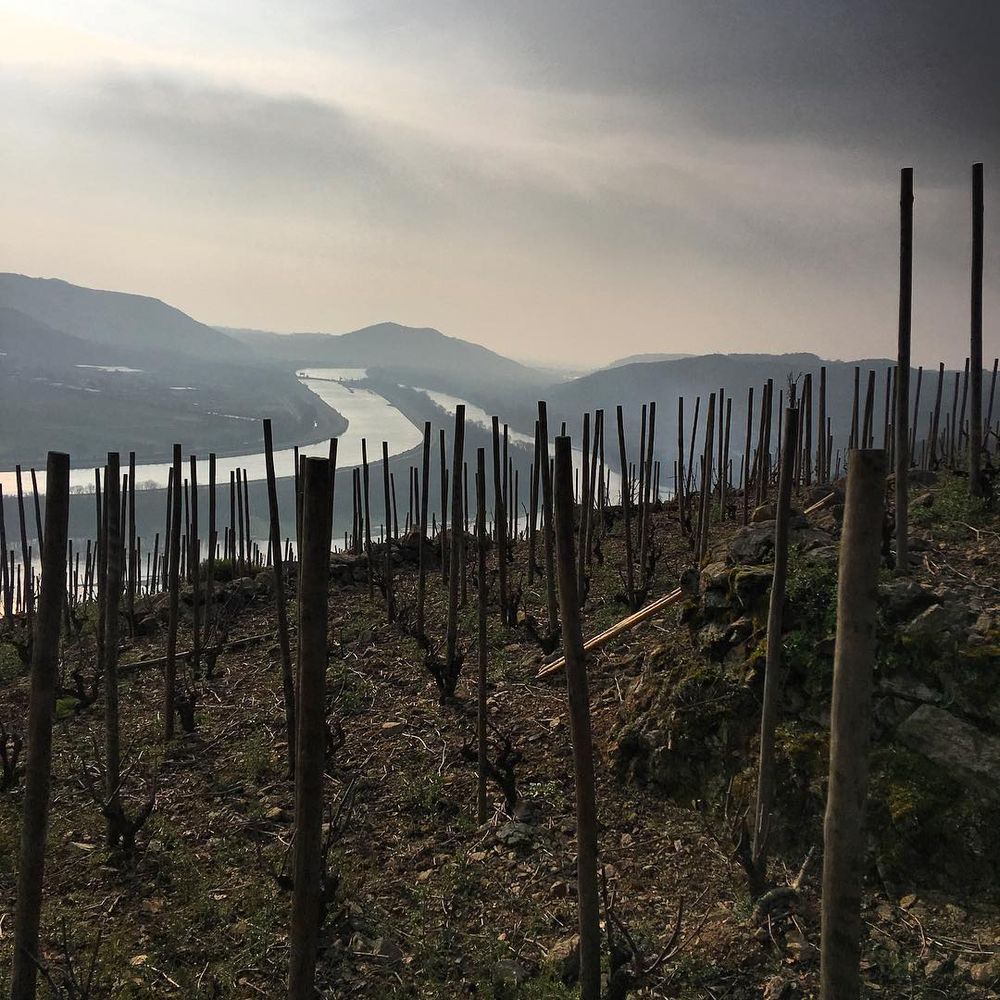
The Northern Rhône is a natural corridor. It runs from Vienne to Valence; from the Mediterranean to Gaul.
What’s in a name?
Saint Joseph produces 87% red wine, 13% white. There is no rosé. In 2022, 1353 hectolitres were bottled with Saint Joseph averaging 38 hl per hectare. The region is really a series of different vineyard communes that might suit their own appellation but were all clubbed together in 1956. Mauves, St Jean-de-Muzols and Tournon are the key villages at the heart of the appellation.
Stylistic and quality variants hold back pricing and to some extent the name of Saint Joseph, and as such it offers excellent value for money. It will never be priced at the same level as Hermitage.
Let’s go into the wines of Saint Joseph in detail
The Syrah offers a spectrum of styles from north to south, from the light and ethereal to the full and rich and everything in between. Ten percent of the red wine is permitted to be made of Marsanne or Roussanne though it very rarely is. Catherine and Pascal Jamet add a little bit of Roussanne into their Saint Joseph Vignobles de la Tour d’Arras red. Co-fermentation stabilises red wine colour and moderates tannin extraction.
Grapes must be hand-harvested, although slopes this vertiginous preclude machine harvesting anyway. The maximum yield is 40 hl per hectare, but you’d be hard pushed to meet it. No woodchip is allowed. Oak use is prevalent because it has a powerful affinity with Syrah, Marsanne and Roussanne. Oak is becoming less obvious and more nuanced in the glass today.
Syrah from the Northern Rhône is said to be firm, full-bodied and savoury. Aromas of lavender, olive, black pepper, smoke, meat, roses and even violets prevail.
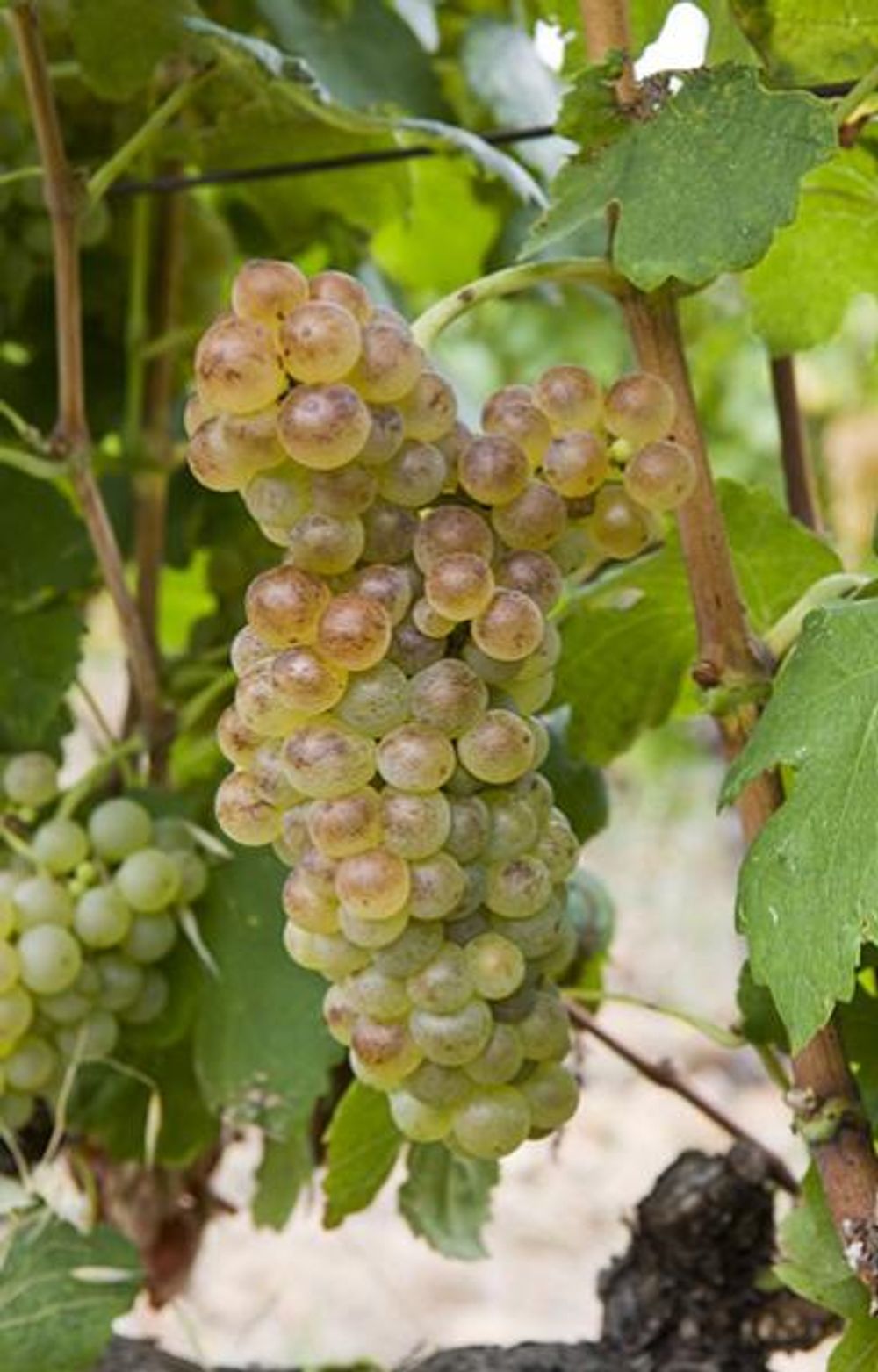
Roussanne is notoriously difficult to grow
White wines
Marsanne and Roussanne are varieties with notable similarities. Both are medium to full-bodied and offer a certain richness. They have low to medium acidity and are therefore never crisp. Two thirds of the white grapes in Saint Joseph are Marsanne, one third is Roussanne.
Roussanne offers notes of pear, honeysuckle and can supply a grainy texture, much like a pear fruit. Marsanne, tends to be more elusive with notes of apricot, peach, mango, rhubarb and a touch of tomato stalk. The main reason two thirds of the white is Marsanne is because Roussanne is very hard to grow. It is prone to botrytis and it tends to brown more easily as it ages, in short it’s harder work.
Prized white vintages
2020 and 2021 are both really good years for whites, 2016 and 2014 too. 2014 was ‘epic’ according to Walls as well as 2004. The right whites will age well for about eight to ten years.
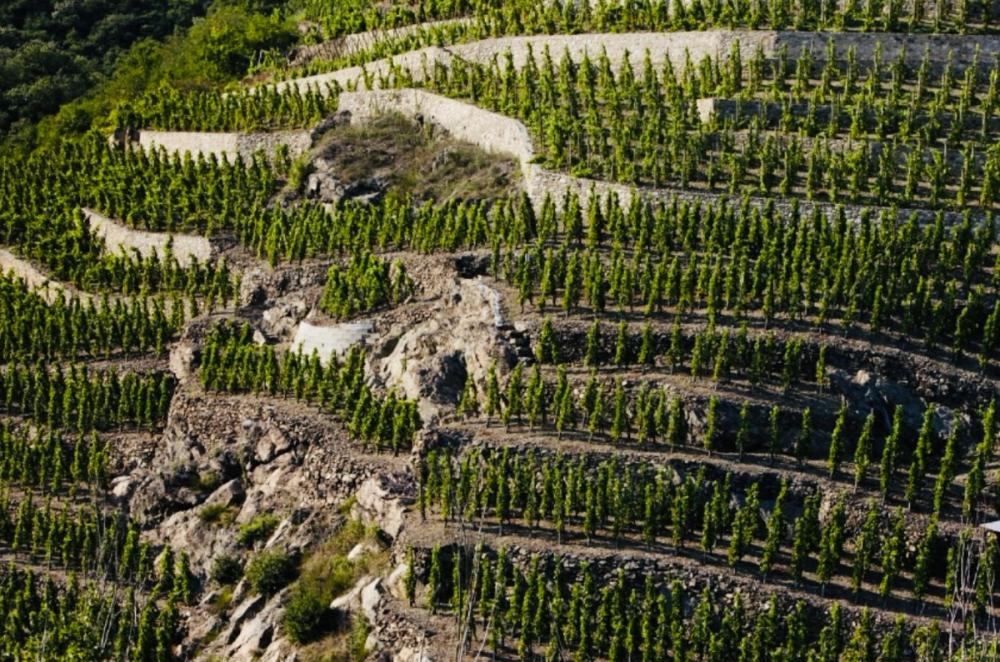
Saint Joseph vineyards: slopes this vertiginous preclude machine harvesting
Red wines of Northern Saint Joseph
The wines of the north are known for their floral, spicy style. Steep slopes here are breath-taking. Ancient terraces proliferate, (some over a thousand years old) with varying exposures from South to Southeast. The violent, dry Mistral aka La Bize, helps to keep the vineyards clean and healthy.
The climate is continental, cooler than the Southern Rhône, consequently it looks very different. No lavender, no olives and the slopes are grassier. Summers are hot. Muscovite granite dominates with patches of schist and gneiss.
Lighter bodied, paler and more fragrant wine redolent with rosé and violets are typical. People often talk about black pepper (rotundone) in Syrah. You rarely find it any more, only in cooler vintages such as 2021. It’s increasingly rare as the climate warms up. Violet, rose and black pepper are the traditional hallmarks of cool climate Syrah.
Red wines of Southern Saint Joseph
The wines of the Southern end of Saint Joseph tend to be more sturdy, broader and more concentrated. The style here is a little bit different, particularly around Tournon. Powerful tannic wines are born of decomposed granite. The climate is slightly warmer, so the wines are generally more concentrated, more tannic.
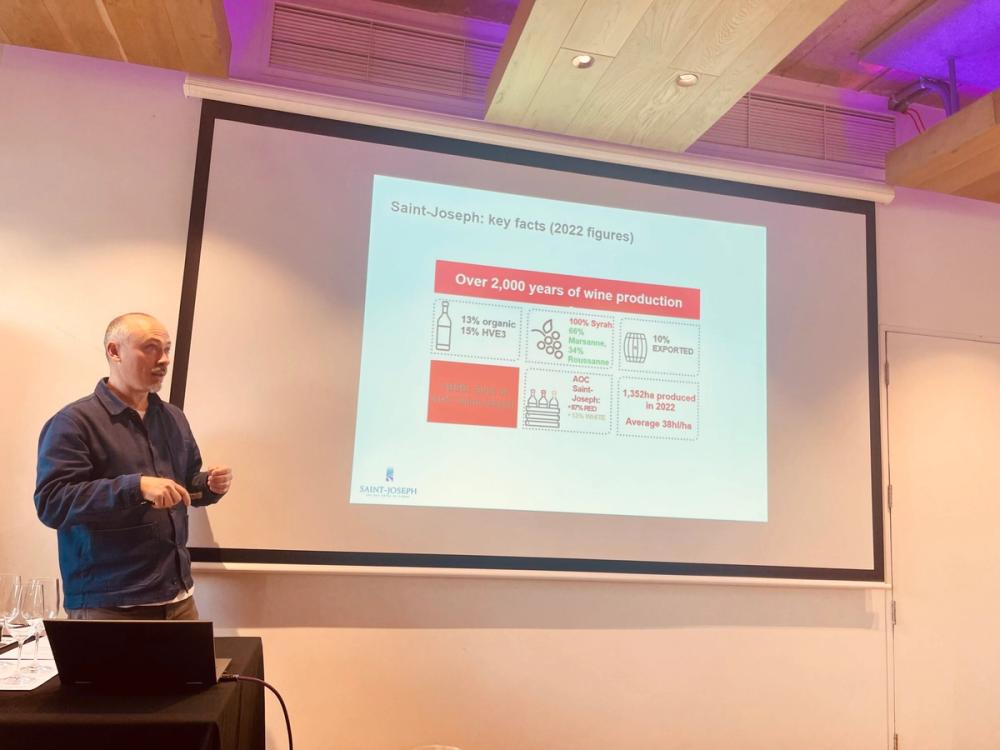
Rhône expert Matt Walls presented three masterclasses on the lesser known appellations of the Rhône
The Saint Joseph wines we tasted…
Les Terriens Saint Joseph, Red, 2020, 13% abv
From a négociant based in Chavanay, which is in the north of Saint Joseph, this wine is made from 100% Syrah grown on south-facing vineyards with granitic sub-soil; the fruit destemmed and the wine then aged for 20 months in barriques and demi-muids, (20% new). This is classic: red fruit, spice, finesse, power, but fresh and light-bodied with a decent acidity. The wine has a more upright feel – lighter and more fragrant, with structures that feel fresh and pure.
In terms of texture you get this slightly chiselled feel to the palate even when the tannins are quite light and ethereal; they are still edgy which gives a palate-cleansing affect. The wine is pretty and requires careful consideration when pairing to avoid overpowering the delicate nuances in the glass.
Retail price: £24.99 Red Fox Wines (2018)
Importer: TBC
Domaine Pierre-Jean Villa, Red, ‘Preface’ 2020, 13% abv
Based in Chavanay, north of Saint Joseph, Burgundian Pierre-Jean Villa, helped to establish Les Vins de Vienne which has amassed 17ha since 2007. He’s a brilliant winemaker. This wine is made from old vine Syrah dating back to 1934 (20%) and the rest from the late 1970s. It is grown on pockets of schist and gneiss and is 60% destemmed and aged for 20-22 months in 60% new 228-litre oak barriques, 40% old. Unfiltered. The wine is fresh, cool, elegant and floral, it offers a spray of sweet blossom notes; Parma violets, rose, red cherry, deep black fruit and a splash of black olive. Moreish chalky-fine tannins.
Retail price: £36.89 Stannary Street (2021)
Importer: Flint
Domaine Coursodon, Red, L’Olivaie 2021, 13% abv
Based in Mauves (together with a clutch of great winemakers), highly regarded, fifth generation, Jérôme Coursodon makes Saint Joseph from 16 hectares of old south east-facing bush vines grown on wooden stakes.
2021 was a difficult vintage marred by frost all over France, wet and rainy too. Many grapes struggled to ripen; you may find greenness in the reds although the whites did really well.
This wine is 100% Syrah, grown on granite, the fruit is then destemmed, and the wine aged for 15 months in barriques, (15% new). Broader, more intense, more concentrated with ripe blackberry fruit and meaty, savoury notes of tapenade. Full bodied and palate-coating. Delicious.
Retail price: £42 (James Nicholson) (2020)
Importer: Charles Taylor
Maison Delas Frères, Red, ‘Sainte-Epine’ 2020, 13% abv
Single vineyard wine from Saint-Jean de Muzols, southern Saint Joseph – the vineyard being located on the other side of the Hill of Hermitage at the same altitude. The wine is made from 100% Syrah, grown on granite, then aged for 16 months in barriques, 50% new. The 2020 vintage was warm and steady but there is a lovely consistent freshness in the wine. Concentrated and fresh, still very young, the wine is smooth, full bodied and dense, powerful, broad and ‘basey’, with notes of cola and clove that come from the oak. Deeply delectable.
Retail price: £50 (Christopher Keiller) (2019)
Importer: Maisons Marques & Domaines
The Whites….
Both of these wines come from the southern part of Saint Joseph although they are very different in style. The first is more Northeast in spirit which is why Walls chose it for the tasting.
Cave Jean-François Jacouton, White ‘Souvenirs d’Andre’, 2021
Established in 2010, Jacouton owns 10ha of vines, mostly in Saint Joseph.
50% Marsanne and 50% Roussanne, grown on granite, the Roussanne planted on an east-facing slope for freshness. Walls says, “This is the style I would expect from the north, though it’s from the south.”
Fermented in stainless steel, then aged for 10 months in 1 to 3-year-old barriques (2/3) and amphorae (1/3). The wine is fresh, waxy, textural and generous. A lovely, moreish, endive bitterness adds structure. Freshness is evident throughout; the finish is almost minty. Absolutely delicious.
Retail price: £38 (Smashing Wines, 2020).
Importer: Wine Story
Domaine Jolivet, White ‘Clef de Sol’ 2021
Styllistically this wine is very different and, according to Walls, is a classic Southern Saint Joseph style.
Based in Saint-Jean de Muzols, in the southern part of the appellation, Bastien Jolivet established the domaine in 2014 with family vineyards. This wine is made from 95% Marsanne, 5% Roussanne, grown on granite with a little loess. The wine is fermented and aged for 12 months in 6% new barriques.
The oak is present; there is ripe mango and pear with malolactic fermentation bringing a creaminess to the finish. There is textural complexity and richness. Sublimely satisfying.
Retail price: £31.68 (Justerini & Brooks)
Importer: Justerini & Brooks
More information about the Saint Joseph appellation

The Northern Rhône is awash with architectural treasures
The History of Saint Joseph
Aggressive Roman armies invaded the Northern Rhône 2000 years ago, although these violent marauders have been warmly recast in gratitude for the structural wonders they left behind.
The Northern Rhône is a natural corridor. It runs from Vienne to Valence; from the Mediterranean to Gaul and is loaded with agricultural treasure. Fine Roman amphitheatres, aqueducts, vine terraces and temples still stand as testament to this natural wealth. The Romans who settled here paved the way for wine and gastronomy by making best use of a region awash with indigenous, edible bounty.
Prior to Roman occupation, the Northern Rhône was settled by a Celtic tribe. The Allobroges first appear in historical testament when Hannibal crossed the Alps and may have been Gallic mercenaries. (Allobroges means those from another country; the exiled).
The Greeks most likely introduced winemaking when they settled at Massalia (modern day Marseilles) in 600 BC. They shipped untold quantities of amphorae into the heart of Gaul up the Rhône River. It was the Romans that constructed the Northern Rhône’s terraces though. Vienne was Rome’s provincial capital and Viennese vinum picatum was widely drunk in Rome itself.
Monks revived winemaking in the 9th century and in the 13th century Pope Clement V moved his entire court from Rome to Avignon in the Southern Rhône where they remained until 1378.
The English supped Rhône in the 18th century, when wines were exported via the Loire. Phylloxera hit the Southern Rhône first in 1863 leading to adulteration and ultimately the invention of the classification system as oenological penance. Châteauneuf-du-Pape imposed a set of rules for production to address fraud. These rules became the prototype for the Appellation Contrôlée system we use today.
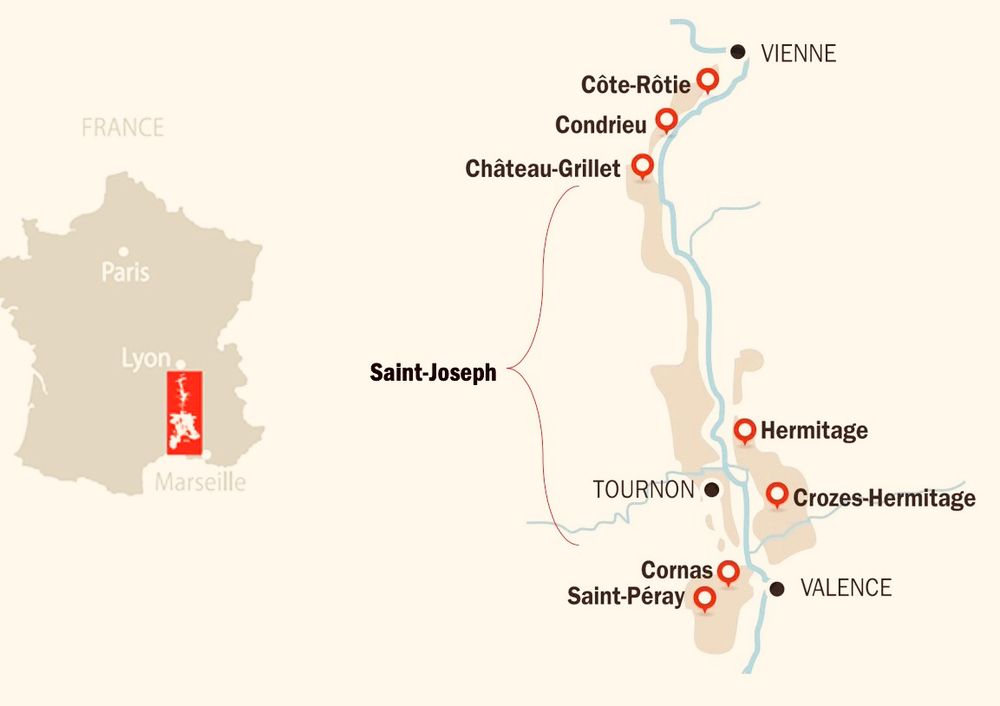
Saint Joseph, the detail…
Saint Joseph is difficult to define, named after a small, famed Jesuit lieu-dit; now an infinitesimal part of a far larger whole, it is not connected to a town or a discernible locale. That said the soil is predominantly granite with a small amount of loess and gneiss. Steep slopes bind the appellation and give it cohesion.
When Saint Joseph AOC was established in 1956 it contained only 100 hectares, previously wines from this region were known as ‘Vin de Mauves’. In 1969 this was enlarged to include 25 villages. This extended the AOC to cover 60 km from Cornas in the South to Condrieu in the North. Today there are 1300 hectares but much growth potential remains. The price of developing vineyards at this gradient is considerable meaning that further development is unlikely. Tireless work to restore ancient terraces is undertaken by the likes of Domaine Jean-Louis Chave whose ancestral home lies in Saint Joseph.
In the past Saint Joseph was labelled as a ‘mediocre’ appellation, most likely because of its size and perceived variability. Yet today it is extremely hard to go wrong when selecting a good wine from this region. The terroir is excellent. Granite slopes imbue the wines with textural character and with, what Matt Walls describes as, “a notion of upright fresh granite;” taut tannins, freshness and fruit purity.
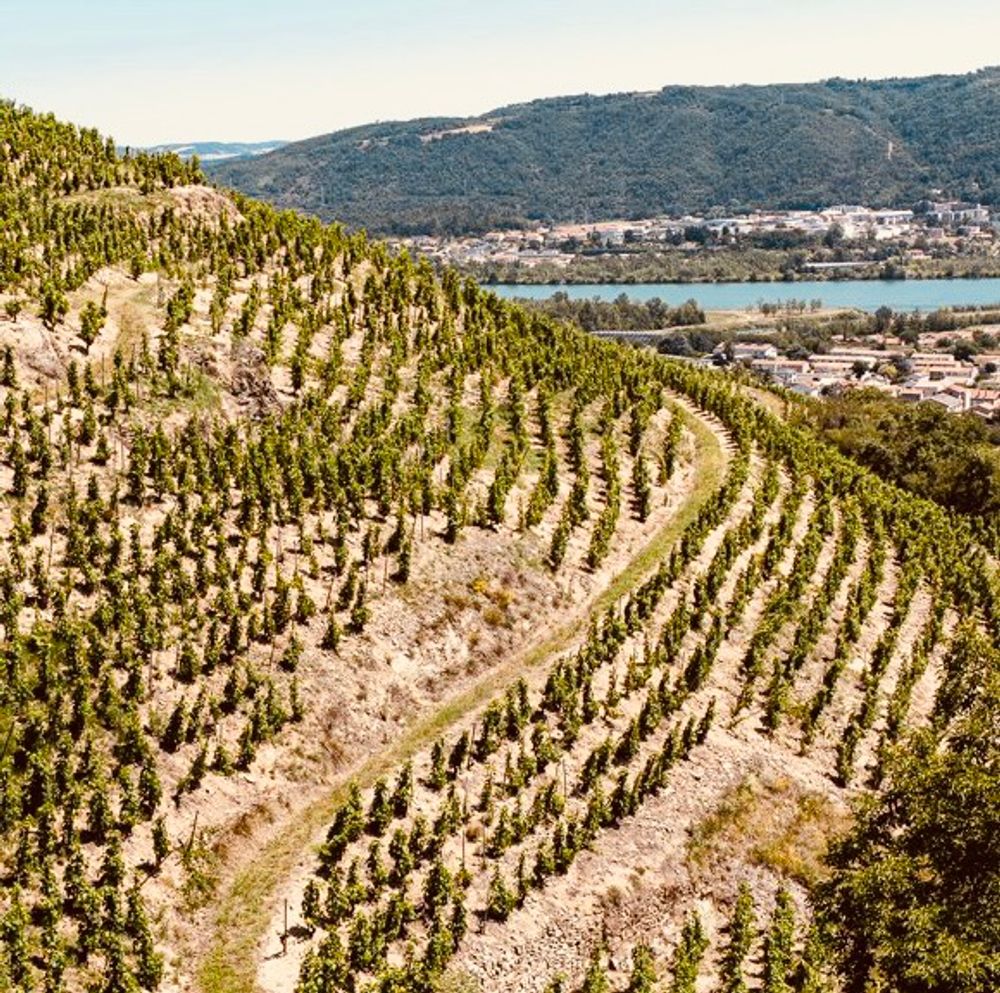
The price of developing vineyards at these gradients means that further expansion is unlikely
Climate, terroir and grapes..
Saint Joseph sits on the 45th parallel and the climate is continental. It is much cooler and wetter in the Northern Rhône than the Mediterranean-influenced Southern Rhône. The Mistral supplies warm winds that guard against mould and mildew. 15% of land is HVE certified, 13% organic. True terroir, wines very loyal to where they come from, are the hallmark of the Northern Rhône.
Syrah is the only red grape. Marsanne and Roussanne are the whites. There is a small amount of Gamay. Only 6% of all Rhône wine originates in the Northern Rhône where geography renders large scale farming impossible.
The land is very hard to work, everything must be done by hand. Morning sun and cooler afternoons are usual, as are low yields and old vines. Steep slopes and terraces, some over a thousand years old, allow for vertiginous viticulture the like of which would not be financially viable today. Were it not for the pre-existing terraces provided by ancient labour, much more land might lie fallow.
The appellation follows the granitic contours of the eastern edge of the Massif Central where there was a considerable volcanic activity 300 million years ago. The valley was carved by the Rhône river and is peppered with limestone, loess and gneiss. Many slopes face east, but the vineyards tend to face south. They lie on the fractures; the monolithic ancient cracks of south-facing slopes, created by age-old rivers. Cooler east-facing vines may become ever more attractive as global warming intensifies.
It is said that the wines of Northern Saint Joseph are closer in spirit to Côte-Rôtie and the Southern Saint Joseph to Cornas. Saint Joseph is an umbrella appellation formed in 1954, that groups together a succession of favourable hillside slopes. In the 1980s there were 500 hectares, in 1994 it was restructured, the very highest and the very lowest land was removed to improve quality. Today there are 1300 hectares. Mauves is one of Saint Joseph’s key villages where vignerons such as Gonon, Gripa and Coursodon have recently raised the reputation of the appellation.
There are three co-operatives and 130 domaines with 30 active négociants; a large proportion of these bottle their wines but most farm only a few hectares – 10 to 20 hectares is about the maximum. On terraces this steep it is hard to farm a lot of land and the work is back breaking.









































